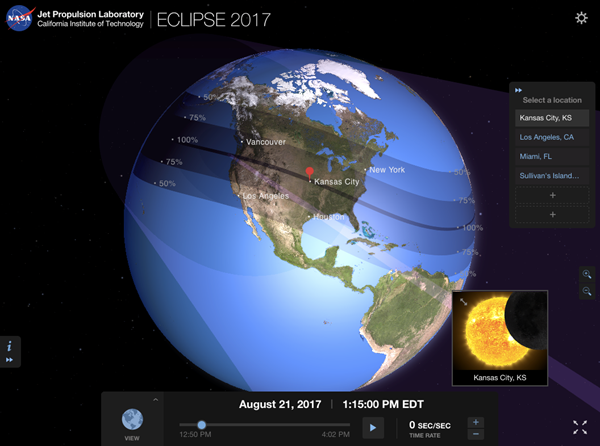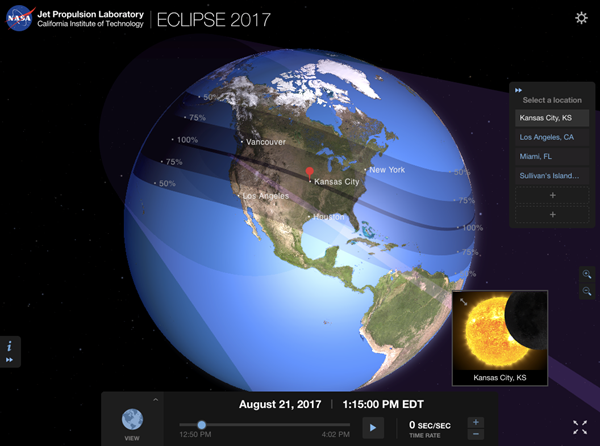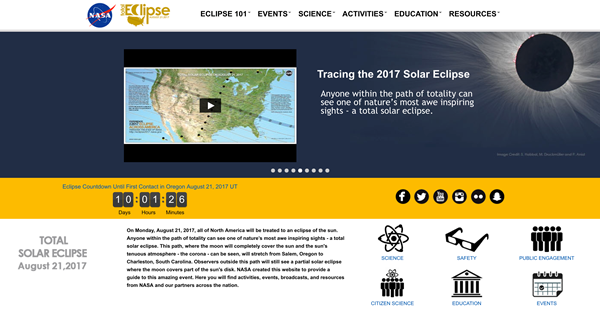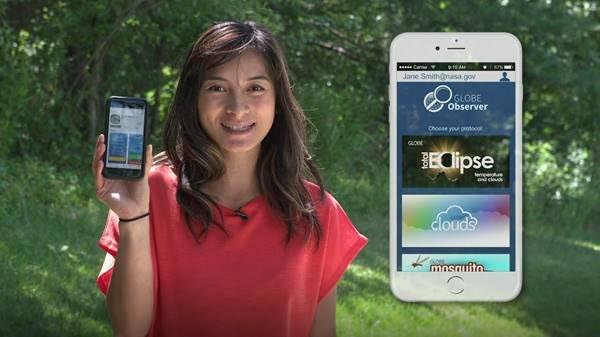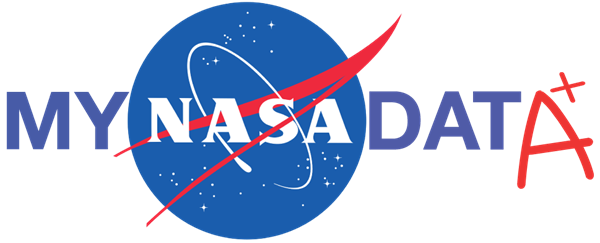This content was originally published by the Longmont Observer and is licensed under a Creative Commons license.
Reproduced with permission from: http://nasawavelength.org/blog/let-eclipse-begin
Let the Eclipse Begin!
Written by Elizabeth Burck and Theresa Schwerin, IGES
Monday, August 21, 2017, could quite possibly be your best science demonstration ever. Just walk outside and immerse learners in one of the most extraordinary astronomy lessons possible. The parts will already be aligned, the time is already set…there will be a solar eclipse on glorious display!
Click on the image above to go to NASA’s Eyes on the 2017 Eclipse 3D Interactive
Beginning on the west coast in the morning and passing over the eastern coastline by mid-afternoon (local time), the eclipse will stretch across North America. Some lucky locations lie within the path of totality in which the moon will completely cover the sun; others will experience a partial solar eclipse. Regardless, observing this phenomenon presents an opportunity to conduct an authentic science investigation and also serves as the perfect segue into other related topics.
NASA Eclipse 2017
NASA has dedicated an entire website to this event where you can access detailed maps, find locations of related events and activities, watch videos, including scientist interviews, download resources, and access educational materials.
Most importantly, check out how to safely view the 2017 eclipse.
Click the image above to go to the NASA Eclipse 2017 Website
Beginning at 12 noon EDT on August 21, NASA Television will air a four-hour show, Eclipse Across America: Through the Eyes of NASA, with unprecedented live video of the eclipse, along with coverage of activities in parks, libraries, stadiums, festivals, and museums across the nation, and on social media. More details can be found at https://eclipse2017.nasa.gov/eclipse-live-stream.
Click the image above to watch a video on GLOBE Observer Eclipse
Citizen Science with GLOBE Observer Eclipse
Download this app for smart phones and tablets, register an account, and get your thermometer ready to collect citizen science data for NASA during the eclipse. Start practicing your cloud observations now – air temperature data collection will become active on August 18! Observations are needed from across North America and are submitted to an international research database that is publicly available. Check out these GLOBE Observer Eclipse Resources including this handy information sheet that walks you through the basics of how and why to observe, and details how the eclipse data collection will work within the app.

Lessons, classroom activities, and other educational resources related to the eclipse are also available on NASA Wavelength. A list of those resources can be quickly accessed by searching for “eclipses.”
Following are curated Wavelength lists of eclipse-related resources:
• Homeschools: http://nasawavelength.org/list/1859
• Science Centers and Museums: http://nasawavelength.org/list/1590
• Eclipse Resources for Elementary Schools: http://nasawavelength.org/list/1860
• Eclipse Resources for Middle Schools: http://nasawavelength.org/list/1861
• Eclipse Resources for High Schools: http://nasawavelength.org/list/1862
To make a copy and personalize any of the lists, be sure to first “Log In” or “Register” using the link on the right side of the blue bar found at the top of the page. Then click on the link to any of the lists above and select “Copy list.”
Then, go beyond the eclipse
Use the eclipse to introduce related science topics and to also integrate other disciplines. For example: investigate the sun, the moon, seasons, orbits, phases, and gravity; introduce Newton and Kepler; connect to math, language arts, history and social studies.
There are many resources, websites, promotions, and celebrations surrounding the eclipse. The topic permeates the news, social media and conversations. As an educator, you have the unique opportunity to provide learners with an understanding of the science behind it. But don’t forget to take the time to simply marvel at it. Then harness the excitement, interest, and wonder to use as the springboard for another incredible year of science learning. What a great beginning!
Here are just a few examples of eclipse and eclipse-related resources available on NASA Wavelength:
Big Sun, Small Moon
http://nasawavelength.org/resource/nw-000-000-003-955/
Using a coin and a plate, students investigate why the sun and moon look similar in size, even though the sun is actually much larger.
Eclipse: An Introduction
http://nasawavelength.org/resource/nw-000-000-003-267/
Introduces eclipses through a series of discussions, book readings, and journal writings. This is Activity 10 of a larger resource entitled “Eye on the Sky.”
Making a Solar Eclipse Book: The Sun and Moon During Solar Eclipse
http://nasawavelength.org/resource/nw-000-000-003-270/
Students paint and label the sun and moon as they appear during a solar eclipse. This is Activity 13 of “Eye on the Sky.”
Teaching Planetary Sciences - Eclipses
http://nasawavelength.org/resource/nw-000-000-004-026/
This is the third in a series of three professional development videos that correspond to lessons taught to 9th and 10th graders by Andrew Cloud, an Earth and planetary sciences teacher. Includes teaching tips and discussion questions.
Measuring Angular Size and Distance
http://nasawavelength.org/resource/nw-000-000-002-249/
Students create a shoebox eclipse simulator, and then apply what they learned about angular size to predict the diameter and distance of one object that can be eclipsed by another.
Our Very Own Star, the Sun
http://nasawavelength.org/resource/nw-000-000-003-164/
A storybook that introduces facts about the sun and its relationship to Earth to children aged 6 and up.
Mysteries of the Sun
https://www.nasa.gov/pdf/637244main_MysteriesOfTheSun_Book.pdf
A guidebook to space weather, solar variability, the heliosphere, Earth’s magnetosphere and upper atmosphere, and the solar mysteries that scientists are still studying.
Plotting the Apparent Daily Motion of the Sun
http://nasawavelength.org/resource/nw-000-000-004-287/
Students use a model to determine the location of sunrise, sunset, and the sun's height at noon.
Think Scientifically: Adventures in the Attic
http://nasawavelength.org/resource/nw-000-000-003-303/
Learners read or listen to a story about two twins, Matt and Matilda, who are tasked with creating a model of the Earth-sun system for a science fair project- leading to a better understanding the causes of Earth's seasons.
Why is Summer Hot?
http://nasawavelength.org/resource/nw-000-000-002-362/
Use a pair of thermometers to show how insolation is affected by latitude.
Click on the image above to go to MY NASA DATA for data rich Earth science classroom activities and lessons
MY NASA DATA
The following activities from MY NASA DATA enable students to use actual NASA data to explore concepts related to seasons and solstices.
Seasons
http://mynasadata.larc.nasa.gov/lesson-plans/?page_id=474?&passid=114
Students connect the idea of the tilt and orbit of the Earth (changing of seasons) with monthly snow/ice data.
The Solstices
http://mynasadata.larc.nasa.gov/?page_id=474?&passid=62
Students compare near surface temperature during solstices in two different hemispheres, and see how the tilt of the Earth's axis in relationship to the sun contributes to temperature differences across the planet.
For additional NASA reviewed educational materials visit: http://nasawavelength.org
Bio:
John Ensworth works from Longmont as the Principle Investigator for the NASA Science Mission Directorate Earth and space science education product review through the IGES (The Institute for Global Environmental Strategies –www.strategies.org) . He is in his 14th year running this review. He is an astronomer (from the 2nd grade onward) and became a meteorologist (in the 5th grade) when a thunderstorm in Arizona rained on his telescope when the weather service had only forecasted a 10% chance of rain. He has college degrees in physics and astronomy and climatology and a graduate degree in meteorology and earth science. He lectures at the Little Thompson Observatory in Berthoud, the Estes Park Memorial Observatory in Estes Park, and for a number of online universities. He built and runs a backyard observatory near Pace and 17th in northeast Longmont where he has lived for 8 years with his wife, daughter, son, and two cats. Invitations to open house nights at this observatory, LTO, and EPMO will be posted with future discussions when they are scheduled.
Forecasting severe weather and snow amounts via text lead to this column. He began texting friends about the weather right after the September 2013 flood. The readers of this column will, hopefully, keep him honest in what he ‘thought’ he had forecasted for ‘the most recent’ storm.
